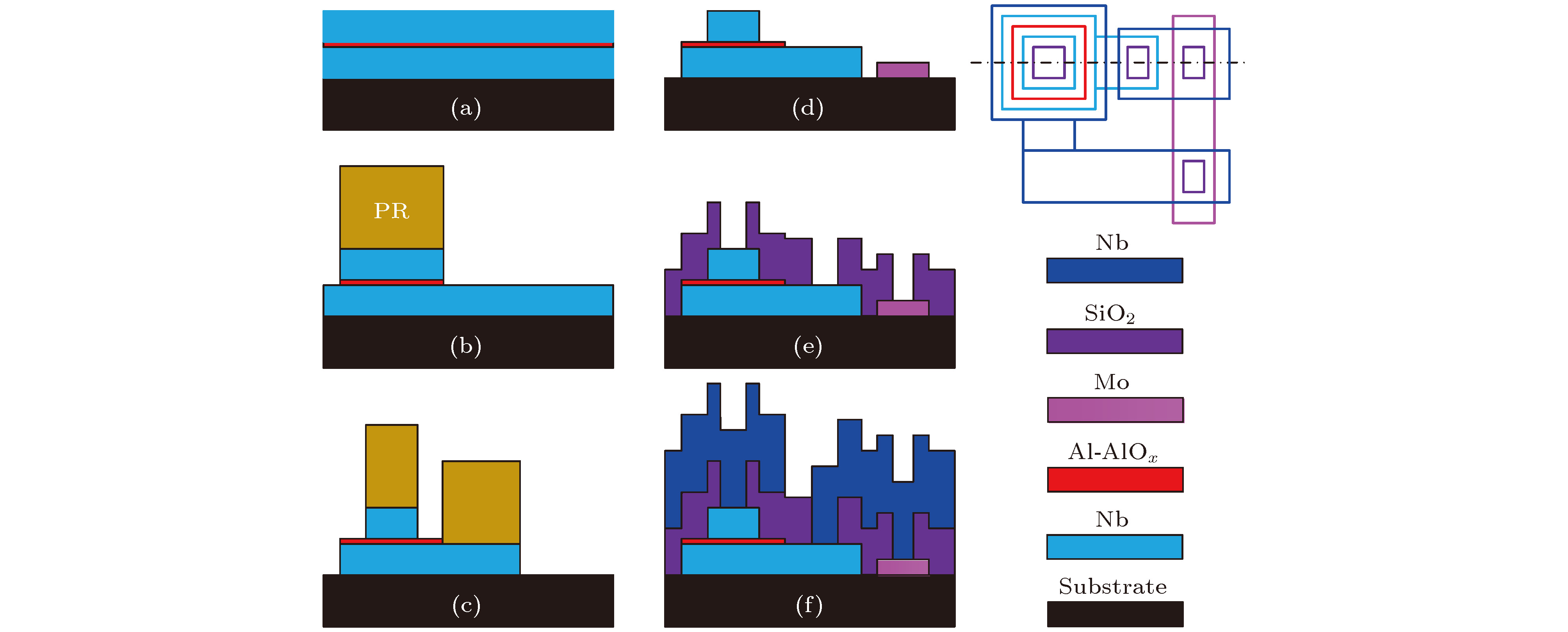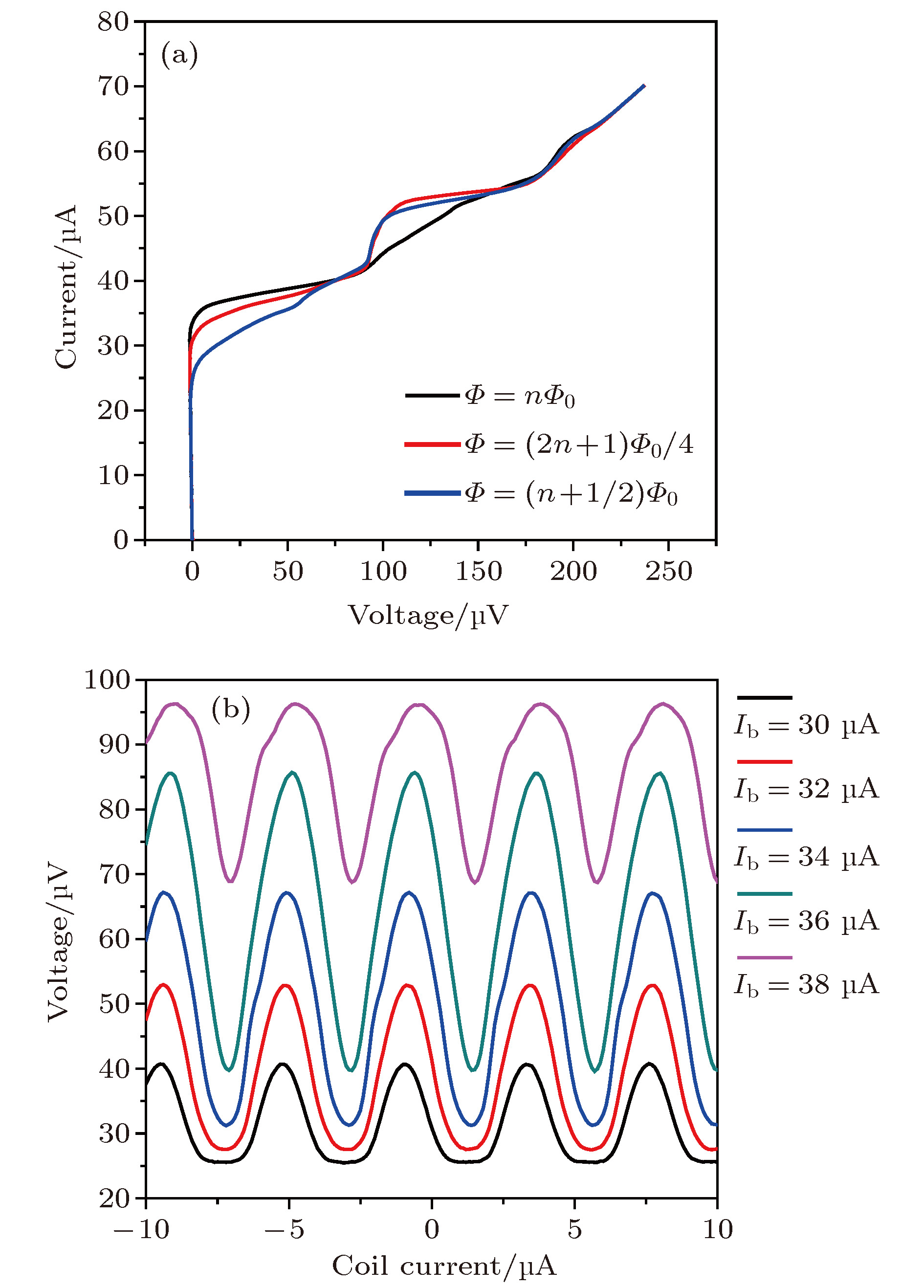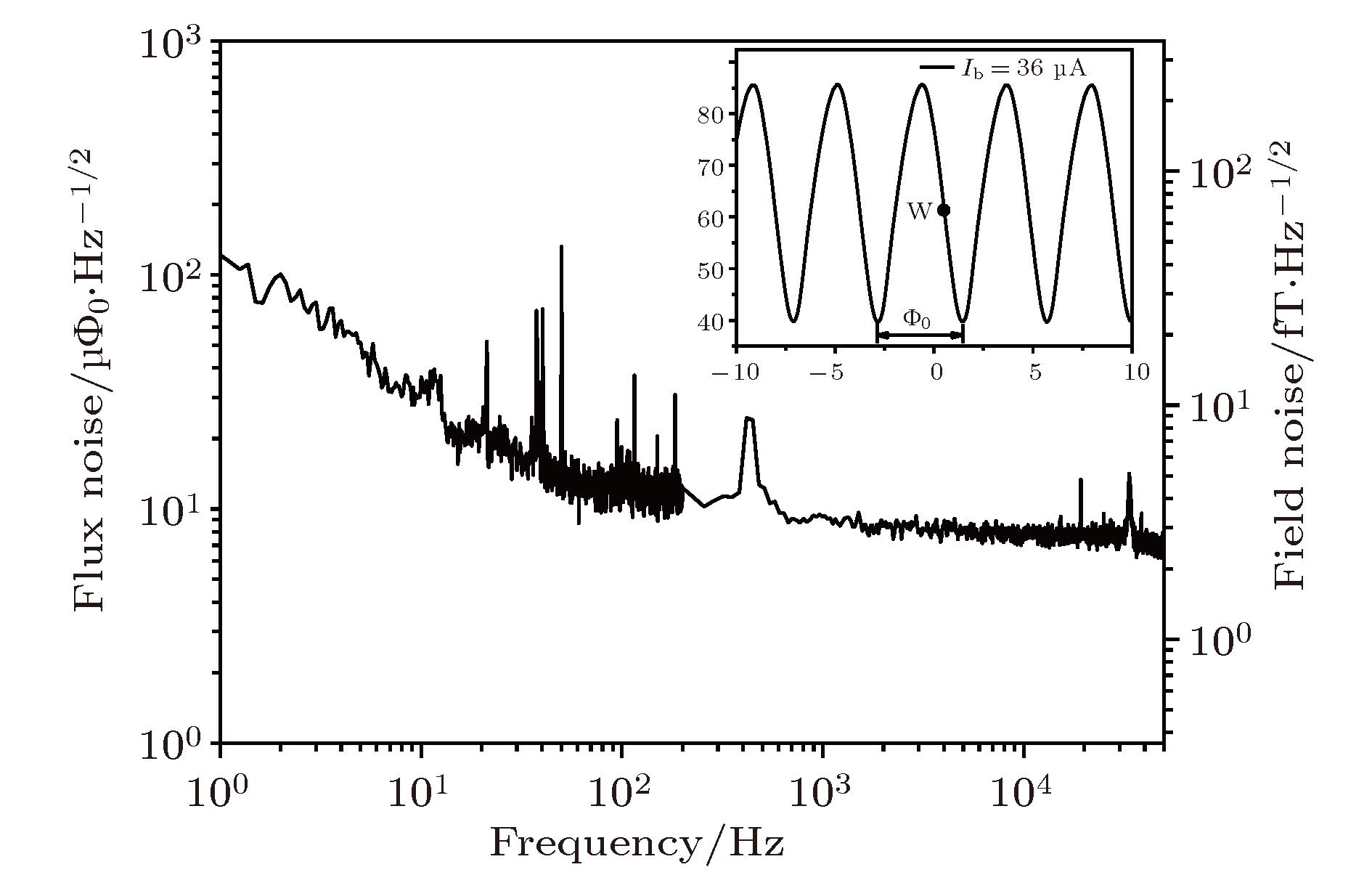-
超导量子干涉器件(superconducting quantum interference device, SQUID)作为一种极灵敏的磁通传感器, 在生物磁探测、低场核磁共振、地球物理等领域得到广泛应用. 本文介绍了一种基于SQUID的高灵敏度磁强计, 由SQUID和一组磁通变压器组成. SQUID采用一阶梯度构型, 增强其抗干扰性. 磁通变压器由多匝螺旋的输入线圈和大尺寸单匝探测线圈组成, 其中输入线圈与SQUID通过互感进行磁通耦合. 利用自主工艺平台, 在4英寸硅衬底上完成了基于Nb/Al-AlOx/Nb约瑟夫森隧道结的SQUID磁强计制备. 低温测试结果显示, 该磁强计磁场灵敏度为0.36 nT/Φ0, 白噪声段磁通噪声为8 μΦ0/√Hz, 等效磁场噪声为2.88 fT/√Hz.Superconducting quantum interference device (SQUID) is the most sensitive magnetic flux sensor known, which is widely used in biomagnetism, low-field nuclear magnetic resonance, geophysics, etc. In this paper, we introduce a high-sensitivity SQUID magnetometer, which consists of an SQUID and a flux transformer. The SQUID is first-order gradiometer configuration, which is insensitive to interference noise. The flux transformer includes a multi-turn spiral input coil and a large-sized pickup coil. And the input coil is inductively coupled to the SQUID through mutual inductance. We present an SQUID magnetometer fabricated with Nb/Al-AlOx/Nb Josephson junction technology on a 4-inch silicon wafer at our superconducting electronics facilities. We develop a fabrication process based on selective niobium etching process consisting of five mask levels. In the first two mask levels, the trilayer is patterned by a dry etch to define base electrode, contact pads, and interconnects. The shunt resistor and a dielectric insulating layer are then deposited and patterned by using lift-off and dry etchant, respectively. Finally, the niobium wiring layer is deposited and patterned by using reactive ion etching to define input, pickup and feedback coils. The measurement of the SQUID magnetometer is performed inside a magnetically shielded room. The operating temperature is realized by immersing the SQUID into the liquid helium (4.2 K). Moreover, a superconducting niobium tube is employed to protect the SQUID from being disturbed by external environments. A homemade readout electronics instrument with low input voltage noise is used to characterize the SQUID magnetometer. The results of low-temperature measurements indicate that the magnetometer has a magnetic field sensitivity of 0.36 nT/Φ0 and a white flux noise of 8 μΦ0/√Hz,corresponding to a white field noise of 2.88 fT/√Hz. This kind of SQUID magnetometer is suitable for multi-channel systems, e.g., magnetocardiography, magnetoencephalography, etc. Although the SQUID process development benefits from the rapid advance of semiconductor process technology, the uniformity of the SQUID on one wafer is fluctuated due to the film deposition. Now, we have realized a best SQUID yield of 50% on a 4-inch wafer. In the future, the SQUID chip yield should be improved by well controlling the optimizing process. The device yield is expected to reach as high as 80%.
[1] Zhang S, Zhang G, Wang Y, Liu M, Li H, Qiu Y, Zeng, J, Kong X, Xie X 2013 Chin. Phys. B 22 128501
 Google Scholar
Google Scholar
[2] Dong H, Wang Y, Zhang S, Sun Y, Xie X 2008 Supercond. Sci. Technol. 21 115009
 Google Scholar
Google Scholar
[3] 荣亮亮, 蒋坤, 裴易峰, 伍俊, 王远 2016 仪器仪表学报 37 12
Rong L, Jiang K, Pei Y, Wu J, Wang Y 2016 Chin. J. Sci. Instrum. 37 12
[4] Josephson B D 1962 Phys. Lett. 1 251
 Google Scholar
Google Scholar
[5] Tesche C D, Clarke J 1977 J. Low Temp. Phys. 27 301
[6] Drung D, Matz H, Koch H 1995 Rev. Sci. Instrum. 66 3008
 Google Scholar
Google Scholar
[7] Schmelz M, Stolz R, Zakosarenko V, Schoenau T, Anders A, Fritzsch L, Mueck M, Meyer H G 2011 Supercond. Sci. Technol. 24 065009
 Google Scholar
Google Scholar
[8] Xie X, Zhang Y, Wang H, Wang Y, Mueck M, Dong H, Krause H J, Braginski A I, Offenhaeusser A, Jiang M 2010 Supercond. Sci. Technol. 23 065016
 Google Scholar
Google Scholar
[9] Zeng J, Zhang Y, Mueck M, Krause H J, Braginski A I, Kong X, Xie X, Offenhaeusser A, Jiang M 2013 Appl. Phys. Lett. 103 042601
 Google Scholar
Google Scholar
[10] Gurvitch M, Washington M A, Hugins H A 1983 Appl. Phys. Lett. 42 472
 Google Scholar
Google Scholar
[11] Zhang G, Zhang Y, Zhang S, Krause H J, Wang Y, Liu C, Zeng J, Qiu Y, Kong X, Dong H, Xie X, Offenhaeusser A, Jiang M 2012 Physica C 480 10
 Google Scholar
Google Scholar
[12] Xiong W, Xu W, Wu Y, Li G, Ying L, Peng W, Ren J, Wang Z 2018 IEEE Trans. Appl. Supercond. 28 1300605
[13] Yuda M, Kuroda K, Nakano J 1987 Jpn. J. Appl. Phys. 2 6
[14] Kuroda K, Yuda M 1988 Jpn. J. Appl. Phys. 63 2352
 Google Scholar
Google Scholar
[15] Imamura T, Hasuo S 1989 IEEE Trans. Magn. 3 3029
[16] Booi P A A, Livingston C A, Benz S P 1993 IEEE Trans. Appl. Supercond. MAG-25 1119
[17] Sukuda K, Kawai J, Uehara G, Kado H 1993 IEEE Trans. Magn. 3 2944
[18] Amos R S, Breyer P E, Huang H H, Lichtenberger A W 1995 IEEE Trans. Magn. 5 2326
[19] Kang X, Ying L, Wang H, Zhang G, Peng W, Kong X, Xie X, Wang Z 2014 Physica C 503 29
 Google Scholar
Google Scholar
[20] Zhao J, Zhang Y, Lee Y H, Krause H J 2014 Rev. Sci. Instrum. 85 054707
 Google Scholar
Google Scholar
[21] Clarke J, Goubau W M, Ketchen M B 1976 J. Low. Temp. Phys. 25 99
[22] Zhang X, Zhang G, Ying L, Xiong W, Han H, Wang Y, Rong L, Xie X, Wang Z 2018 Physica C 548 1
-
表 1 SQUID磁强计设计参数
Table 1. Design parameters of SQUID~magnetometer
参数 数值 单位 约瑟夫森结Josephson junction 尺寸AJ 4 × 4 μm2 临界电流Ic 8 μA 结电容C[12] 0.56 pF 并联电阻R 10 Ω SQUID 垫圈内边长a 100 μm 线宽ws 300 μm 总电感Ls 350 pH 输入线圈 线圈匝数N 15 — 线宽win 3 μm 线距sin 3 μm 探测线圈 线圈尺寸Ap 15 × 15 mm2 线宽wp 100 μm 表 2 Nb/Al-AlOx/Nb三层膜生长参数
Table 2. Deposition parameters of Nb/Al-AlOx/Nb trilayer.
薄膜 背景真空 Ar流量 Ar气压 恒电流 生长速率 厚度 底层Nb 2.3 × 10–5 Pa 10 sccm 0.573 Pa 1.5 A 1.2 nm/s 100 nm Al 3 × 10–5 Pa 10 sccm 0.573 Pa 0.3 A 0.25 nm/s 10 nm AlOx 氧气气压:2.6 kPa; 氧化时间:12 h ~2 nm 顶层Nb 2.3 × 10–5 Pa 10 sccm 0.573 Pa 1.5 A 1.2 nm/s 100 nm 表 3 SQUID磁强计测试结果
Table 3. Measured results of SQUID magnetometer
参数 数值 单位 临界电流I0 32 μA 正常态电阻Rn 5 Ω 反馈线圈耦合系数1/Mf 4.3 μA/Φ0 最大调制峰峰值Vpp 47 μV 磁通噪声√SΦ(白噪声) 8 μΦ0/√Hz 磁场灵敏度1/Aeff 0.36 nT/Φ0 磁场噪声√SB(白噪声) 2.88 fT/√Hz -
[1] Zhang S, Zhang G, Wang Y, Liu M, Li H, Qiu Y, Zeng, J, Kong X, Xie X 2013 Chin. Phys. B 22 128501
 Google Scholar
Google Scholar
[2] Dong H, Wang Y, Zhang S, Sun Y, Xie X 2008 Supercond. Sci. Technol. 21 115009
 Google Scholar
Google Scholar
[3] 荣亮亮, 蒋坤, 裴易峰, 伍俊, 王远 2016 仪器仪表学报 37 12
Rong L, Jiang K, Pei Y, Wu J, Wang Y 2016 Chin. J. Sci. Instrum. 37 12
[4] Josephson B D 1962 Phys. Lett. 1 251
 Google Scholar
Google Scholar
[5] Tesche C D, Clarke J 1977 J. Low Temp. Phys. 27 301
[6] Drung D, Matz H, Koch H 1995 Rev. Sci. Instrum. 66 3008
 Google Scholar
Google Scholar
[7] Schmelz M, Stolz R, Zakosarenko V, Schoenau T, Anders A, Fritzsch L, Mueck M, Meyer H G 2011 Supercond. Sci. Technol. 24 065009
 Google Scholar
Google Scholar
[8] Xie X, Zhang Y, Wang H, Wang Y, Mueck M, Dong H, Krause H J, Braginski A I, Offenhaeusser A, Jiang M 2010 Supercond. Sci. Technol. 23 065016
 Google Scholar
Google Scholar
[9] Zeng J, Zhang Y, Mueck M, Krause H J, Braginski A I, Kong X, Xie X, Offenhaeusser A, Jiang M 2013 Appl. Phys. Lett. 103 042601
 Google Scholar
Google Scholar
[10] Gurvitch M, Washington M A, Hugins H A 1983 Appl. Phys. Lett. 42 472
 Google Scholar
Google Scholar
[11] Zhang G, Zhang Y, Zhang S, Krause H J, Wang Y, Liu C, Zeng J, Qiu Y, Kong X, Dong H, Xie X, Offenhaeusser A, Jiang M 2012 Physica C 480 10
 Google Scholar
Google Scholar
[12] Xiong W, Xu W, Wu Y, Li G, Ying L, Peng W, Ren J, Wang Z 2018 IEEE Trans. Appl. Supercond. 28 1300605
[13] Yuda M, Kuroda K, Nakano J 1987 Jpn. J. Appl. Phys. 2 6
[14] Kuroda K, Yuda M 1988 Jpn. J. Appl. Phys. 63 2352
 Google Scholar
Google Scholar
[15] Imamura T, Hasuo S 1989 IEEE Trans. Magn. 3 3029
[16] Booi P A A, Livingston C A, Benz S P 1993 IEEE Trans. Appl. Supercond. MAG-25 1119
[17] Sukuda K, Kawai J, Uehara G, Kado H 1993 IEEE Trans. Magn. 3 2944
[18] Amos R S, Breyer P E, Huang H H, Lichtenberger A W 1995 IEEE Trans. Magn. 5 2326
[19] Kang X, Ying L, Wang H, Zhang G, Peng W, Kong X, Xie X, Wang Z 2014 Physica C 503 29
 Google Scholar
Google Scholar
[20] Zhao J, Zhang Y, Lee Y H, Krause H J 2014 Rev. Sci. Instrum. 85 054707
 Google Scholar
Google Scholar
[21] Clarke J, Goubau W M, Ketchen M B 1976 J. Low. Temp. Phys. 25 99
[22] Zhang X, Zhang G, Ying L, Xiong W, Han H, Wang Y, Rong L, Xie X, Wang Z 2018 Physica C 548 1
计量
- 文章访问数: 17634
- PDF下载量: 355
- 被引次数: 0














 下载:
下载:




